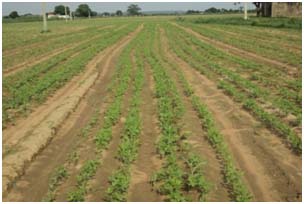Nidhan is about 30 km away from its district headquarter Morena, Madhya Pradesh. The village receives an annual average rainfall of 450 mm concentrated in the months of July and August. While much of the village depends on rainfed agriculture, the main source of irrigation in the rabi (winter) season is borewells. There are recurrent droughts in the village and most borewells dry up during low rainfall years.
The topography of the village is such that there is waterlogging in the lowlands because of which lands are left fallow during the kharif (monsoon) season. At the same time, the uplands in the village face problems due to frost in vegetable patches and orchards during the winters. Pests and diseases in the crops are common. Also, there is poor access to improved seeds and farm machinery in addition to shortage of labour.
View Nidhan in a larger map
To combat all these issues and use water efficiently, the village approached the local Krishi Vigyan Kendra. Equipped with innovative approaches that cut down on water consumption, farmers in Nidhan village have started looking for ways to grow two crops in a year. Scores of farmers have adopted short duration pigeon pea and water efficient practices like dry sowing methods for wheat.
Local Krishi Vigyan Kendra to the rescue!

Dr. Y. P. Singh, Director of the Krishi Vigyan Kendra explains that while doing this, they found a solution for avoiding the wheat crop from getting affected by terminal heat during March-April. To mitigate the adverse effects on wheat crop in pigeon pea-wheat cropping sequence, the Krishi Vigyan Kendra was able to introduce new approaches in management of irrigation.
Drought or temperature-tolerant varieties of wheat were introduced. Planting dates of wheat crop that faces terminal heat stress was advanced. A total of 125 farm families of the village have adopted this approach.
Dr. Singh adds that this village is one of many where extensive technology demonstrations of location-specific best-bet practices are being done as a part of National Initiative on Climate Resilient Agriculture (NICRA) (1). This national project launched in year 2011 aims at enhancing resilience of Indian agriculture to climate change. Given the presence of Krishi Vigyan Kendras in every district of the country they were entrusted with the responsibility of directing and organizing the demonstrations in 100 vulnerable districts of the country.
Experimenting with options
Shifting from the age-old methods, farmers of the village along with the Krishi Vigyan Kendra started experimenting with various options. Dr. Singh says that a comparison of yields was done for pre-irrigation before and after harvesting of pigeon pea. It was found that the yields were around 11 per cent in the latter.
Dry sowing methods for planting wheat after pigeon pea crop were tried. This was to save time taken in seed bed sowing and first irrigation, locally known as paleva irrigation, which can easily take up 10-15 days. Immediate sowing of wheat with minimal land preparation saved energy while bypassing the paleva irrigation saved water. This also ensured a uniform crop stand.
Alarmed by the falling water level the farmers introduced efficient practices for water use. The farmers started irrigating the fields twice. The first was done immediately post-sowing to ensure that the wheat crop germinates properly and the second was provided after 40 to 45 days of first irrigation. The fields were irrigated by making beds and channels so as to use water efficiently.
The farmers from Nidhan began participating in meetings held at the Krishi Vigyan Kendra. They introduced minimum tillage in their farms. (2) The productivity of wheat thus achieved was 53.8 qtl/ha as per Krishi Vigyan Kendra.

No-till farming in some villages
The Krishi Vigyan Kendra claims that zero tillage through custom hire service has been adopted by thirty two farmers of the village. They were involved in sowing of 50 ha wheat by zero tillage sowing method during 2012-13 resulting in production of an additional 112 quintals of grain. This brought about savings of Rs 1.88 lakh in the village.
The innovative message of zero tillage cultivation of wheat has spread in neighbouring villages in the districts and around 200 ha in the district was covered during current rabi in 2013. It can be safely said that these practices have produced higher yield and profit.
And all this has been possible when the Krishi Vigyan Kendra along with experimenting with different crops and agronomic practices in its own field, tried to demonstrate ‘proven’ crop-practice in as many farmers field as possible. This helped create a critical mass. The farmers see this as a new way of doing agriculture. And most of all, as a way of enhancing resilience of farming systems to changes in climate.
Endnotes and references
(1) The project aims to enhance resilience of Indian agriculture to climate change and climate variability through strategic research and technology demonstration. The research on adaptation and mitigation covers crops, livestock, fisheries and natural resource management. The project consists of four components viz. Strategic Research, Technology Demonstration, Capacity Building and Sponsored/Competitive Grants.
(2) This entailed one harrowing, two ploughing followed by planking and sowing of wheat variety GW-366 or MP-4010. The sowing was done in line through seed cum fertilizer drill. Green manuring was also tried using dhaincha (Sesbania).













